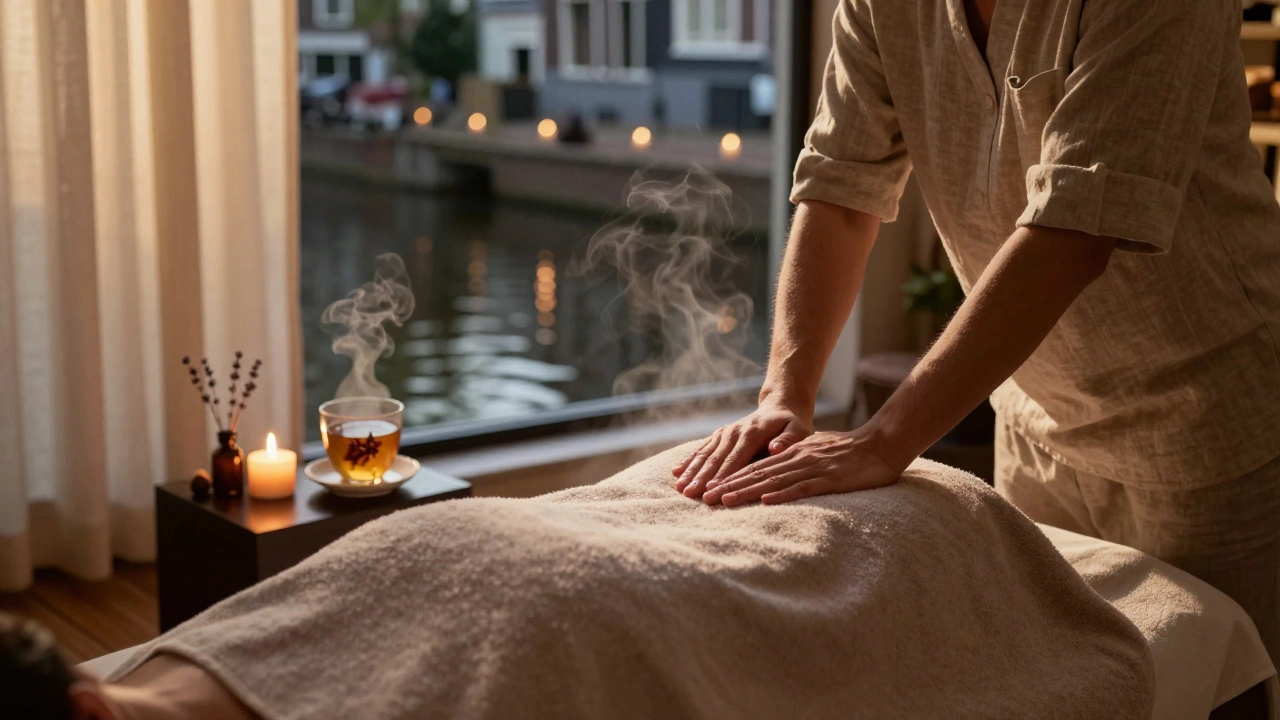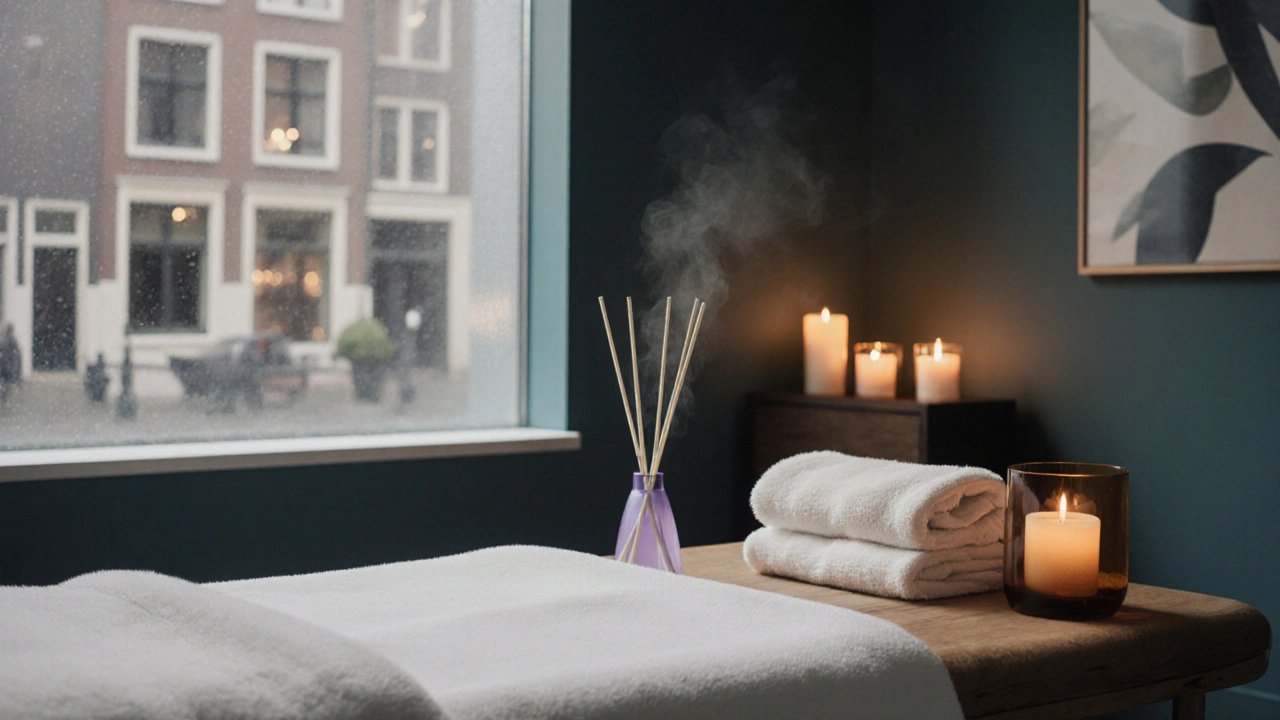The Importance of Breathwork in Tantra Massage

You’ve probably heard that tantra massage isn’t just about touch-it’s about presence. But what if the real secret isn’t in the hands of the practitioner, but in the rhythm of your own breath? Most people walk into a tantra session expecting relaxation. They leave with something deeper: a quiet mind, a grounded body, and a sense of connection they didn’t know they were missing. That shift doesn’t come from pressure or technique alone. It comes from breathwork.
Why Breathwork Is the Hidden Engine of Tantra Massage
Think of breath as the invisible thread tying together every touch, every pause, every moment of stillness in a tantra massage. Without it, the experience becomes just another type of bodywork-pleasant, maybe even soothing, but ultimately surface-level. With it, you unlock something older, deeper: a return to the natural rhythm your body knew before stress, distraction, and trauma taught you to hold your breath.In tantra, breath isn’t a side note. It’s the foundation. When your breathing slows and deepens, your nervous system shifts from fight-or-flight to rest-and-digest. Your muscles soften. Your heart rate drops. Your awareness expands. That’s when the massage stops being something done to you and becomes something you experience with your whole being.
Studies on vagal tone show that slow, diaphragmatic breathing increases heart rate variability-a key marker of resilience and emotional balance. In a tantra session, the practitioner doesn’t just guide your hands or hips. They guide your breath. Not by telling you to ‘breathe deeper,’ but by modeling it. By slowing their own rhythm. By pausing just long enough for you to notice the gap between inhale and exhale. That’s where the magic happens.
How Breathwork Changes the Experience
Most massage techniques focus on releasing tension in the muscles. Tantra massage goes further-it releases tension in the energy field, the emotional body, the subconscious. And breath is the key that unlocks it.Here’s what happens when breathwork is woven into the session:
- You stop mentally checking out. When you’re focused on the rise and fall of your belly, there’s less room for racing thoughts about work, bills, or what you’ll have for dinner.
- Physical sensations become clearer. A tight shoulder isn’t just ‘sore’-it becomes a signal. A warm pulse in your lower abdomen? That’s not random. It’s your body speaking.
- Emotions surface gently. Without breath, trauma gets buried. With breath, it surfaces like a tide-soft, inevitable, and safe to release.
- Connection deepens. When two people breathe in sync, even silently, a bond forms. It’s primal. It’s human. It’s why couples often say tantra massage felt more intimate than sex.
I’ve seen clients cry during a shoulder rub-not because of pain, but because a single long exhale unlocked a memory they’d buried for years. Another client, a corporate lawyer who hadn’t slept through the night in months, told me she finally felt ‘light’ after just one session. Not because of the oil or the strokes. Because she remembered how to breathe.
Types of Breathwork Used in Tantra Massage
Not all breathwork is the same. In tantra, the techniques are chosen based on intention and sensitivity. Here are the most common types you’ll encounter in a professional session in Amsterdam:- Diaphragmatic Breathing: The foundation. Inhale through the nose, letting the belly expand like a balloon. Exhale slowly through the mouth. This activates the parasympathetic nervous system instantly.
- Coherent Breathing: Breathing at a rate of 5-6 breaths per minute (inhale for 5 seconds, exhale for 5). This rhythm has been shown in clinical studies to reduce cortisol and improve mood within minutes.
- Box Breathing: Inhale for 4, hold for 4, exhale for 4, hold for 4. Used to ground clients who feel overwhelmed or dissociated during the session.
- Wave Breathing: A flowing, undulating breath that moves energy from the feet to the crown. Often paired with long, slow strokes along the spine or limbs.
- Conscious Pausing: Not breathing at all-for a few seconds. This isn’t about holding your breath in stress. It’s about stillness. About noticing what’s there when the breath stops.
Practitioners in Amsterdam rarely use loud chanting or forced techniques. Tantra here is quiet, subtle, and deeply personal. The breathwork is never forced. It’s invited.
What to Expect During a Breathwork-Integrated Tantra Session
Your session might begin with you lying fully clothed on a warm mat, eyes closed. The room smells of sandalwood and beeswax candles. The practitioner sits beside you, silent, breathing slowly. After a few minutes, they’ll gently place a hand on your lower back-not to move you, but to ground you.Then comes the invitation: ‘Notice your breath. Let it find its own rhythm.’ No commands. No pressure.
As the massage begins-gentle strokes along your legs, light pressure on your sacrum, fingers tracing your collarbone-you start to notice how your breath changes. Sometimes it gets shallow. Sometimes it catches. That’s okay. The practitioner doesn’t rush you. They wait. They breathe with you. They mirror your rhythm until you begin to match theirs.
At some point, you might feel warmth spreading through your pelvis. Or a tingling in your fingertips. Or tears you didn’t know you were holding. None of it is ‘wrong.’ It’s all part of the process. Breathwork creates space for the body to release what it’s been storing.
By the end, you’re not just relaxed. You’re reset. Like your system got a reboot. You might feel lighter. Quieter. More present. And you’ll likely notice-after you leave-that you’re breathing deeper, even when you’re not thinking about it.

How to Find a Tantra Massage Practitioner Who Uses Breathwork in Amsterdam
Not every tantra massage in Amsterdam includes breathwork. Some are purely sensual. Others are spiritual. A few are both. To find the right one:- Look for practitioners who mention ‘conscious breathing,’ ‘energetic presence,’ or ‘nervous system regulation’ in their descriptions.
- Avoid those who focus only on ‘erotic’ or ‘sexual release’-those are often just sensual massage with a spiritual label.
- Check reviews for phrases like ‘I felt held,’ ‘I cried without shame,’ or ‘I didn’t realize I was holding my breath until they helped me release it.’
- Ask directly: ‘Do you incorporate breathwork into your sessions?’ A good practitioner will explain how, not just say yes.
Some trusted studios in Amsterdam include Stillness & Flow in De Pijp and The Sacred Space near the Jordaan. Both emphasize breath as central to the experience. Don’t be afraid to book a 30-minute consultation first. A good practitioner will welcome the chance to explain their approach.
Cost and Booking: What You Need to Know
A full tantra massage session with breathwork in Amsterdam typically lasts 90 to 120 minutes and costs between €120 and €180. Why the range? Because depth matters. A session that includes breathwork, energetic clearing, and integration time takes more skill and time than one that’s just about touch.Most practitioners require booking in advance-often weeks ahead. Sessions are limited, not because they’re exclusive, but because each one demands full presence. You won’t find walk-ins. And you shouldn’t want them.
Payment is usually cash or bank transfer. No credit cards. This isn’t about convenience-it’s about intention. The act of paying in a way that feels real helps anchor the experience in your body.
What to Avoid: Safety and Ethics
Tantra massage is safe when done ethically. But there are red flags:- Anyone who pressures you to undress fully or touch them.
- Anyone who promises ‘sexual awakening’ as a result.
- Anyone who doesn’t ask for consent before each new touch.
- Anyone who uses aggressive breathing techniques without checking in.
True tantra is about empowerment, not surrender. You’re always in control. Your breath, your boundaries, your pace. If you feel uncomfortable, you say so. A good practitioner will stop immediately, without question or explanation.
Also, avoid sessions that happen in hotels or private homes without clear boundaries. In Amsterdam, most reputable practitioners work in clean, quiet studios with clear policies. Trust your gut. If something feels off, it probably is.

Breathwork in Tantra vs. Other Massage Types in Amsterdam
| Feature | Tantra Massage with Breathwork | Swedish Massage | Deep Tissue Massage | Thai Massage |
|---|---|---|---|---|
| Primary Goal | Energy flow, emotional release, presence | Relaxation, muscle tension relief | Chronic pain, deep muscle release | Flexibility, energy line alignment |
| Role of Breath | Core component-guided and synchronized | Usually ignored | Occasionally mentioned | Some breath cues during stretches |
| Touch Style | Slow, intentional, full-body | Effleurage, light to medium pressure | Deep, focused pressure | Active, assisted stretching |
| Client Participation | Required-breathing and awareness | Passive | Passive | Some active movement |
| After-Effect | Emotional clarity, sustained calm | Short-term relaxation | Physical relief, possible soreness | Increased mobility |
Notice the difference? Tantra isn’t just another massage. It’s a practice. And breath is its heartbeat.
Frequently Asked Questions
Do I need to be spiritual to benefit from breathwork in tantra massage?
No. You don’t need to believe in chakras, energy fields, or any spiritual system. Breathwork works on a physiological level-slowing your heart rate, lowering cortisol, calming your nervous system. Many people who come in skeptical leave surprised by how deeply relaxed they feel. It’s biology, not belief.
Can breathwork in tantra massage help with anxiety or trauma?
Yes. Many therapists in Amsterdam use tantra massage as a complementary tool for trauma recovery. The combination of safe touch and conscious breathing helps rewire the nervous system’s response to stress. It’s not a replacement for therapy, but for many, it’s a powerful bridge back to feeling safe in their own body.
What if I can’t breathe deeply? I’m always holding my breath.
That’s normal. Most people are holding their breath without realizing it. A good practitioner won’t push you. They’ll start with the tiniest breath-just noticing the air moving in and out. Over time, your body learns again. It’s not about doing it right. It’s about being with it.
Is tantra massage with breathwork only for couples?
Absolutely not. Most clients come alone. In fact, solo sessions are often more powerful because there’s no distraction, no performance, no expectation to please anyone but yourself. Tantra is about reconnecting with your own energy-whether you’re partnered or not.
How many sessions do I need to feel a difference?
Some people feel it after one session-like a weight lifted. Others need three to five to fully reset their nervous system. Think of it like learning to swim. The first time, you’re just getting used to the water. By the third time, you’re floating. Consistency matters more than intensity.
Ready to Breathe Again?
You don’t need to fix yourself. You don’t need to change. You just need to remember how to breathe-deeply, slowly, without shame. Tantra massage with breathwork doesn’t give you something new. It helps you return to something you already had: your own calm, your own rhythm, your own quiet power.Book a session. Lie down. Let your breath lead. And see what happens when you stop trying to control everything-and just let yourself be held, by the air, by the hands, by the silence.



Yzak victor
November 6, 2025 AT 23:33Actually, the vagal tone research they cited is solid-HRV improvements from coherent breathing are backed by HeartMath and even some military stress studies. But what they left out is that breathwork only works if you’re not already in chronic sympathetic overdrive. If your cortisol’s through the roof from burnout, you can’t just ‘breathe deeper’ and expect magic. You need weeks of consistency, sleep hygiene, and maybe even therapy to reset the baseline. Tantra’s nice, but it’s not a bandaid for systemic exhaustion.
Kiara F
November 8, 2025 AT 10:42This whole post is dangerously naive. Breathwork is not a substitute for real mental health care. People with trauma shouldn’t be encouraged to ‘let emotions surface’ during a massage with a stranger-especially if they’re not licensed therapists. This is spiritual bypassing wrapped in incense. If you’re crying during a shoulder rub, you need a counselor, not a candlelit room with oil and vague promises of ‘energy flow.’
Nelly Naguib
November 8, 2025 AT 13:43OH MY GOD. I cried during my first session and I swear I saw my dead grandma’s face. This isn’t massage-it’s a soul reset. I used to hold my breath like I was waiting for a punchline to life, but now? I breathe like I’m breathing for the first time since I was five. The practitioner didn’t even touch my chest, but I felt like someone finally unclamped my ribs. I told my boss I was quitting. I don’t care about the salary anymore. I need to breathe. I need to feel. I need to be held by air, not by deadlines. This changed me. Like, bone-deep, soul-scraping, cry-in-the-shower-for-three-days changed me.
Nicole Ilano
November 10, 2025 AT 03:43As a somatic psychotherapist, I’m thrilled to see breathwork being normalized-but let’s clarify terminology. ‘Tantra massage’ is a misnomer here. What’s described is more aligned with polyvagal-informed somatic experiencing with breath synchronization. The ‘wave breathing’ technique? That’s essentially a form of respiratory sinus arrhythmia modulation. And ‘conscious pausing’? That’s interoceptive exposure, not mysticism. Also, avoid studios that use ‘sacred space’ in their branding-90% of them are unlicensed and using spiritual jargon to evade liability. Look for practitioners with certifications in Somatic Experiencing or Sensorimotor Psychotherapy. And yes, I’ve seen this work wonders for PTSD patients. Just don’t call it tantra.
Susan Baker
November 10, 2025 AT 16:08Look, I get the appeal of this whole breathwork-as-spiritual-panacea narrative, but let’s not oversimplify neurobiology. The parasympathetic activation from diaphragmatic breathing is real, but it’s transient unless paired with neuroplasticity-based interventions. The fact that they mention ‘emotional release’ without addressing the role of the amygdala’s fear conditioning or the prefrontal cortex’s regulatory function is a red flag. People aren’t just ‘holding their breath’ because of stress-they’re holding it because their nervous system learned that safety is conditional. Breathwork alone doesn’t rewire that. It can facilitate awareness, sure, but without cognitive reappraisal, exposure therapy, or attachment-based grounding techniques, you’re just giving people a temporary physiological high and calling it healing. Also, the cost? €180 for a 2-hour session? That’s predatory pricing disguised as sacred service. If this is about ‘intention,’ why not teach people how to do this themselves for free? There are literally free guided breathwork meditations on YouTube that are just as effective for the average person. This feels less like holistic healing and more like wellness capitalism with a yoga mat.